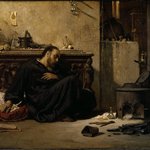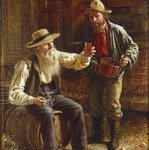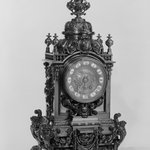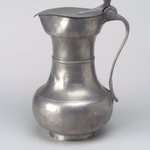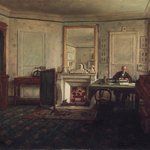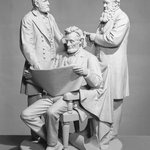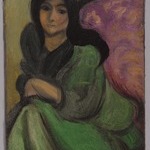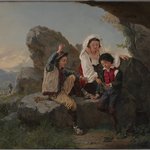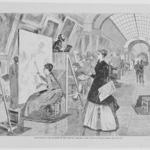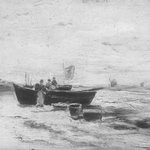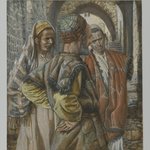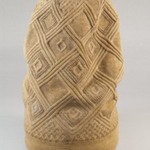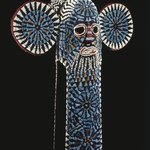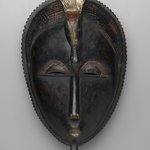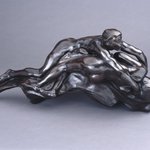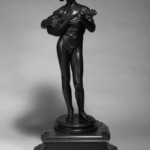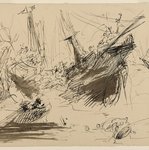
Why Born Enslaved!
Jean-Baptiste Carpeaux
European Art
The identity of the Black woman who posed for this sculpture is unknown, but recent scholarship suggests that she might have been born into slavery in the French Antilles and, following her emancipation, migrated to France. Created twenty years after France abolished slavery in 1848, and only three years following emancipation in the United States in 1865, the bust was meant to appeal to the antislavery views of a progressive white audience. Yet despite its sensitive portrayal of an individual, the bust nonetheless objectifies the Black female body as an exoticized other, her single bare breast a symbol of both liberty and colonial fantasy.
This woman was also the model for the allegorical figure of Africa on a large fountain representing the four continents that Carpeaux designed for a park in Paris. This plaster is one of the independent sculptures he made based on that figure.
This woman was also the model for the allegorical figure of Africa on a large fountain representing the four continents that Carpeaux designed for a park in Paris. This plaster is one of the independent sculptures he made based on that figure.
MEDIUM
Plaster with patina; red stone base
DATES
1868
DIMENSIONS
sculpture: 13 3/4 × 9 1/4 × 7 in. (34.9 × 23.5 × 17.8 cm)
base: 9 × 12 1/2 × 12 1/2 in. (22.9 × 31.8 × 31.8 cm)
weight with base: 43.5 lb. (19.73kg)
mount: 14 × 9 × 7 1/2 in. (35.6 × 22.9 × 19.1 cm) (show scale)
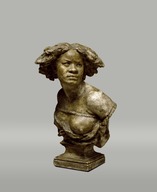


INSCRIPTIONS
Incised back of plaster base: "J-B Carpeaux 1868"
Incised on front of base: "Pourquoi nâitre esclave"
COLLECTIONS
European Art
ACCESSION NUMBER
1993.83a-b
CREDIT LINE
Gift of Benno Bordiga, by exchange and Mary Smith Dorward Fund
MUSEUM LOCATION
This item is not on view
CAPTION
Jean-Baptiste Carpeaux (French, 1827-1875). Why Born Enslaved!, 1868. Plaster with patina; red stone base, sculpture: 13 3/4 × 9 1/4 × 7 in. (34.9 × 23.5 × 17.8 cm). Brooklyn Museum, Gift of Benno Bordiga, by exchange and Mary Smith Dorward Fund, 1993.83a-b. Creative Commons-BY (Photo: Brooklyn Museum, 1993.83a-b_edited_SL3.jpg)
IMAGE
overall, 1993.83a-b_edited_SL3.jpg. Brooklyn Museum photograph, 2015
"CUR" at the beginning of an image file name means that the image was created by a curatorial staff member. These study images may be digital point-and-shoot photographs, when we don\'t yet have high-quality studio photography, or they may be scans of older negatives, slides, or photographic prints, providing historical documentation of the object.
RIGHTS STATEMENT
Creative Commons-BY
You may download and use Brooklyn Museum images of this three-dimensional work in accordance with a Creative Commons license. Fair use, as understood under the United States Copyright Act, may also apply.
Please include caption information from this page and credit the Brooklyn Museum. If you need a high resolution file, please fill out our online application form (charges apply).
For further information about copyright, we recommend resources at the United States Library of Congress, Cornell University, Copyright and Cultural Institutions: Guidelines for U.S. Libraries, Archives, and Museums, and Copyright Watch.
For more information about the Museum's rights project, including how rights types are assigned, please see our blog posts on copyright.
If you have any information regarding this work and rights to it, please contact copyright@brooklynmuseum.org.
RECORD COMPLETENESS
Not every record you will find here is complete. More information is available for some works than for others, and some entries have been updated more recently. Records are frequently reviewed and revised, and we welcome any additional information you might have.
